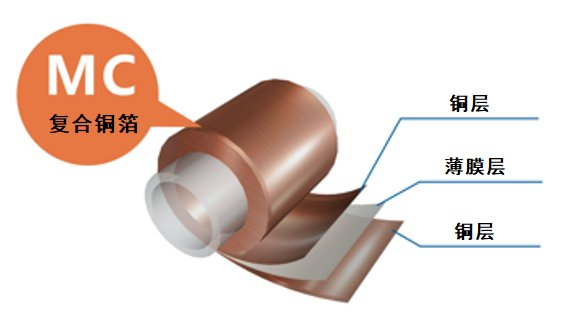

Hotline:0755-22277778
Tel:0755-22277778
Mobile:13826586185(Mr.Duan)
Fax:0755-22277776
E-mail:duanlian@xianjinyuan.cn
Composite copper foilIt refers to a new type of material made by uniformly depositing copper on the surface of plastic films such as PET, PP, PI using magnetron sputtering, evaporation, ion exchange, and other methods. Advanced Institute Technology predicts that the penetration rate will exceed 10% by 2025, and the demand for composite copper foil market is expected to increase from 198 million yuan to 16.919 billion yuan from 2022 to 2025, with a compound annual growth rate of up to 360%.

1. Two step method: magnetron sputtering water medium electroplating
1) Magnetron sputtering activates polymer films. Due to the non-conductive surface of PET/PP, direct electroplating is not possible. Therefore, surface treatment and activation of the polymer material are required, followed by sputtering to form a material with a square resistance of less than 2 Ω (thickness of approximately 30nm-70nm)Metal copper film;
2) Thicken the metal layer through water-based electroplating to achieve conductivity. After forming the basic copper film by magnetron sputtering, the copper layers on both sides are thickened to about 1 µ m by aqueous medium electroplating, achieving the function of current collector conductivity, which is similar to traditional copper foil technology.
Magnetron sputtering is a physical vapor deposition (PVD) method that accelerates argon ions to bombard the surface of a copper target under strong vacuum electric field conditions, causing sputtering of the copper target material. The sputtered copper atoms deposit on the surface of the PET substrate to form a thin copper layer of 30-70nm.
Water medium electroplating refers toPET PP PI base filmAfter magnetron sputtering (vacuum evaporation), there is conductivity, and both sides of the plating solution are electrified for metallization deposition.
Specifically, the workpiece to be plated is placed in an electrolyte solution (such as copper sulfate) with the cathode connected, and the metal plate is connected to the anode (such as copper balls). Under the action of external direct current, the copper metal enters the plating solution in the form of divalent copper ions and continuously migrates to the surface of the cathode for reduction reaction. Electrons are obtained on the cathode and reduced to copper metal, gradually forming a copper plating layer on the workpiece. Water electroplating has fast speed, high production efficiency, and micron level copper plating can be formed in one go.
2. Three step method: magnetron sputtering, vacuum evaporation, aqueous medium electroplating
Adding a vacuum evaporation step after magnetron sputtering aims to increase the deposition rate. The deposition rate of vacuum evaporation is 3-4 times that of magnetron sputtering, which can quickly replenish the copper film to a thickness suitable for electroplating.
Vacuum deposition is a physical vapor deposition (PVD) method that melts metal into a liquid state, forms metal vapor that begins to evaporate, and then condenses copper atoms in the vapor onto the surface of PET for deposition and growth.
The basic principles of two-step and three-step methods are the same, but there are differences in specific performance, process cost, and yield:
| Two-step method |
three-step approach |
|
| performance |
preferably |
Vacuum evaporation results in larger particles, limited improvement in uniformity, and a risk of scalding the base film |
| Yield rate |
preferably |
There is a problem of high-temperature burn on PET substrate in vacuum evaporation |
| production efficiency |
Relatively slow |
preferably Vacuum evaporation deposition has higher efficiency and can deposit to the thickness of the seed copper layer faster |
| production costs |
Relatively low |
Three step method adds vapor deposition equipment (expected to cost 8 million yuan per unit) |
Sputtering/Electroplating Process:
The starting material for sputtering/electroplating processes is a heat-resistant film with good dimensional stability. The initial step is to form a crystal implant layer on the surface of the activated polyimide film using sputtering technology. This crystal planting layer can ensure the bonding strength to the conductor substrate layer, while also serving as the conductor layer for electroplating. Usually nickel or nickel alloy is used, and in order to ensure conductivity, a thin layer of copper is sputtered on the nickel or nickel alloy layer, and then electroplated to a specified thickness of copper.
Composite copper foilIt refers to a new type of material made by uniformly depositing copper on the surface of plastic films such as PET, PP, PI using magnetron sputtering, evaporation, ion exchange, and other methods. Advanced Institute Technology predicts that the penetration rate will exceed 10% by 2025, and the demand for composite copper foil market is expected to increase from 198 million yuan to 16.919 billion yuan from 2022 to 2025, with a compound annual growth rate of up to 360%.
1. Two step method: magnetron sputtering water medium electroplating
1) Magnetron sputtering activates polymer films. Due to the non-conductive surface of PET/PP, direct electroplating is not possible. Therefore, surface treatment and activation of the polymer material are required, followed by sputtering to form a metal copper film with a square resistance of less than 2 Ω (thickness of approximately 30nm-70nm);
2) Thicken the metal layer through water-based electroplating to achieve conductivity. After forming the basic copper film by magnetron sputtering, the copper layers on both sides are thickened to about 1 µ m by aqueous medium electroplating, achieving the function of current collector conductivity, which is similar to traditional copper foil technology.
Magnetron sputtering is a physical vapor deposition (PVD) method that accelerates argon ions to bombard the surface of a copper target under strong vacuum electric field conditions, causing sputtering of the copper target material. The sputtered copper atoms deposit on the surface of the PET substrate to form a thin copper layer of 30-70nm.
Water medium electroplating refers to the process of depositing metalization on PET PP PI base film after magnetron sputtering (vacuum evaporation), which has conductivity, by conducting electricity on both sides of the plating solution.
Specifically, the workpiece to be plated is placed in an electrolyte solution (such as copper sulfate) with the cathode connected, and the metal plate is connected to the anode (such as copper balls). Under the action of external direct current, the copper metal enters the plating solution in the form of divalent copper ions and continuously migrates to the surface of the cathode for reduction reaction. Electrons are obtained on the cathode and reduced to copper metal, gradually forming a copper plating layer on the workpiece. Water electroplating has fast speed and high production efficiency,Micron level copper platingIt can be molded in one go.
2. Three step method: magnetron sputtering, vacuum evaporation, aqueous medium electroplating
Adding a vacuum evaporation step after magnetron sputtering aims to increase the deposition rate. The deposition rate of vacuum evaporation is 3-4 times that of magnetron sputtering, which can quickly replenish the copper film to a thickness suitable for electroplating.
Vacuum deposition is a physical vapor deposition (PVD) method that melts metal into a liquid state, forms metal vapor that begins to evaporate, and then condenses copper atoms in the vapor onto the surface of PET for deposition and growth.
The basic principles of two-step and three-step methods are the same, but there are differences in specific performance, process cost, and yield:
| Two-step method |
three-step approach |
|
| performance |
preferably |
Vacuum evaporation results in larger particles, limited improvement in uniformity, and a risk of scalding the base film |
| Yield rate |
preferably |
There is a problem of high-temperature burn on PET substrate in vacuum evaporation |
| production efficiency |
Relatively slow |
preferably Vacuum evaporation deposition has higher efficiency and can deposit to the thickness of the seed copper layer faster |
| production costs |
Relatively low |
Three step method adds vapor deposition equipment (expected to cost 8 million yuan per unit) |
Sputtering/Electroplating Process:
The starting material for sputtering/electroplating processes is a heat-resistant film with good dimensional stability. The initial step is to form a crystal implant layer on the surface of the activated polyimide film using sputtering technology. This crystal planting layer can ensure the bonding strength to the conductor substrate layer, while also serving as the conductor layer for electroplating. Usually nickel or nickel alloy is used, and in order to ensure conductivity, a thin layer of copper is sputtered on the nickel or nickel alloy layer, and then electroplated to a specified thickness of copper.
If you need this product or would like to learn more about related issues or product information, please contact us. We will solve your problems and provide services:


Advanced Institute (Shenzhen) Technology Co., Ltd, © two thousand and twenty-onewww.leird.cn. All rights reservedGuangdong ICP No. 2021051947-1 © two thousand and twenty-onewww.xianjinyuan.cn. All rights reservedGuangdong ICP No. 2021051947-2